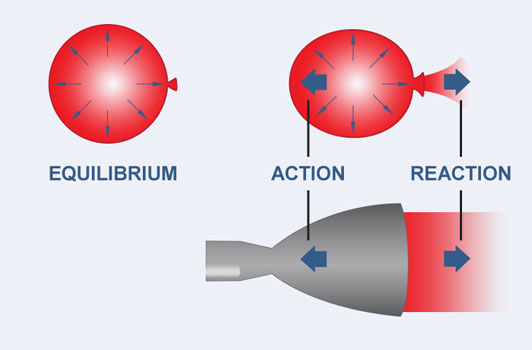How does propulsion in space work
Discussion
Moonhawk said:
The amount of thrust is a function of the mass of the propellant and the speed at which it is chucked out the back.
That's why ion engines are so good - they only use a small amount of fuel - but they chuck it out at very high speed.
But the thrust of an ion engine is really poor (often measured in milli newtons)because the mass is so small, but does have the advantage of consuming very little 'propellant' and in theory can build very high speeds by running for very long 'burn' times.That's why ion engines are so good - they only use a small amount of fuel - but they chuck it out at very high speed.
Silver Smudger said:

Does this help? - In the balloon (or rocket), the pressure is pushing against the inside of the balloon equally until it is allowed to escape at one end so it can then push forward on the inside of the front of the balloon
Edited by Silver Smudger on Sunday 26th February 18:19
If it was in space the balloon would pop!
talksthetorque said:
Silver Smudger said:

Does this help? - In the balloon (or rocket), the pressure is pushing against the inside of the balloon equally until it is allowed to escape at one end so it can then push forward on the inside of the front of the balloon
Edited by Silver Smudger on Sunday 26th February 18:19
If it was in space the balloon would pop!
Eric Mc said:
Another technique used to manoeuver an object in space are reaction control wheels. These have the advantage of not needing any sort of rocket fuel or gas so, in theory, can be used for as long as they have an electricity supply or don't physically break.
Not really propulsion though, just a sort of gyroscope. ie it will rotate around centre of mass but not actually go anywhere.Silver Smudger said:

Does this help? - In the balloon (or rocket), the pressure is pushing against the inside of the balloon equally until it is allowed to escape at one end so it can then push forward on the inside of the front of the balloon
Edited by Silver Smudger on Sunday 26th February 18:19
talksthetorque said:
No, because in this example the expelled air also has air to push against.
If it was in space the balloon would pop!
Nearly there then.If it was in space the balloon would pop!
Just after you've started your rocket in space, what's immediately behind the rocket?
Some gas that has just come out of the rocket.
The gas that is about to come out of your rocket has some gas immediately behind it to push against.
davepoth said:
talksthetorque said:
No, because in this example the expelled air also has air to push against.
If it was in space the balloon would pop!
Nearly there then.If it was in space the balloon would pop!
Just after you've started your rocket in space, what's immediately behind the rocket?
Some gas that has just come out of the rocket.
The gas that is about to come out of your rocket has some gas immediately behind it to push against.
There is no need whatsoever for anything outside the rocket for the gas to 'push' against.
Eric Mc said:
I often wonder if old Isaac is saying to himself "After 300 years, why don't people still not get it?"
He is saying it out loud in the afterlife pub, and then Shakespeare is leaning over and saying 'I never was nor never will' understand why double negatives are still a mystery too. Eric Mc said:
I often wonder if old Isaac is saying to himself "After 300 years, why don't people still not get it?"
To be honest Eric I think Sir Isaac would actually be thinking they did not get it, but at least did not get the plague like in my days and caused problems with my research.Sir Isaac would teach in this case, not disparage.
Edited by Gandahar on Tuesday 7th March 23:07
Gassing Station | Science! | Top of Page | What's New | My Stuff


